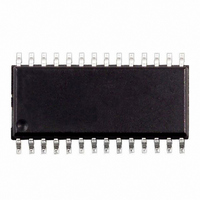M41ST87WMX6 STMicroelectronics, M41ST87WMX6 Datasheet - Page 13

M41ST87WMX6
Manufacturer Part Number
M41ST87WMX6
Description
IC SUPERVISOR RTC 160X8 28-SOIC
Manufacturer
STMicroelectronics
Type
Clock/Calendar/Supervisorr
Specifications of M41ST87WMX6
Memory Size
160B
Time Format
HH:MM:SS:hh (24 hr)
Date Format
YY-MM-DD-dd
Interface
I²C, 2-Wire Serial
Voltage - Supply
2.7 V ~ 3.6 V
Operating Temperature
-40°C ~ 85°C
Mounting Type
Surface Mount
Package / Case
28-SOIC, 28-SOH (8.48mm Width)
Function
Clock/Calendar/Alarm/Timer Interrupt
Rtc Memory Size
160 Byte
Supply Voltage (max)
3.6 V
Supply Voltage (min)
2.7 V
Maximum Operating Temperature
+ 85 C
Minimum Operating Temperature
- 40 C
Mounting Style
SMD/SMT
Rtc Bus Interface
Serial (2-Wire, I2C)
Lead Free Status / RoHS Status
Lead free / RoHS Compliant
Other names
497-5370-5
M41ST87WMX6
M41ST87WMX6
Available stocks
Company
Part Number
Manufacturer
Quantity
Price
Part Number:
M41ST87WMX6
Manufacturer:
ST
Quantity:
20 000
Company:
Part Number:
M41ST87WMX6TR
Manufacturer:
MBI
Quantity:
12 000
M41ST87Y, M41ST87W
2.1
2.1.1
2.1.2
2.1.3
2.1.4
2.1.5
2-wire bus characteristics
The bus is intended for communication between different ICs. It consists of two lines: a clock
signal (SCL) and a bidirectional data signal (SDA). The SDA line must be connected to a
positive supply voltage via a pull-up resistor.
●
●
●
Accordingly, the following bus conditions have been defined:
Bus not busy
Both data and clock lines remain high.
Start data transfer
A change in the state of the data line, from high to low, while the clock is high, defines the
START condition.
Stop data transfer
A change in the state of the data line, from low to high, while the clock is high, defines the
STOP condition.
Data valid
The state of the data line represents valid data when, after a start condition, the data line is
stable for the duration of the high period of the clock signal. The data on the line may be
changed during the low period of the clock signal. There is one clock pulse per bit of data.
Each data transfer is initiated with a start condition and terminated with a stop condition.
The number of data bytes transferred between the start and stop conditions is not limited.
The information is transmitted byte-wide and each receiver acknowledges with a ninth bit.
By definition a device that gives out a message is called “transmitter,” the receiving device
that gets the message is called “receiver.” The device that controls the message is called
“master.” The devices that are controlled by the master are called “slaves.”
Acknowledge
Each byte of eight bits is followed by one acknowledge bit. This acknowledge bit is a low
level put on the bus by the receiver whereas the master generates an extra acknowledge
related clock pulse. A slave receiver which is addressed is obliged to generate an
acknowledge after the reception of each byte that has been clocked out of the transmitter.
The device that acknowledges has to pull down the SDA line during the acknowledge clock
pulse in such a way that the SDA line is a stable low during the high period of the
acknowledge related clock pulse. Of course, setup and hold times must be taken into
account. A master receiver must signal an end of data to the slave transmitter by not
generating an acknowledge on the last byte that has been clocked out of the slave. In this
The following protocol has been defined:
Data transfer may be initiated only when the bus is not busy.
During data transfer, the data line must remain stable whenever the clock line is high.
Changes in the data line, while the clock line is high, will be interpreted as control
signals.
Doc ID 9497 Rev 9
Operating modes
13/54













